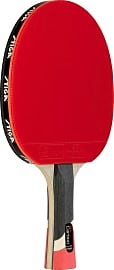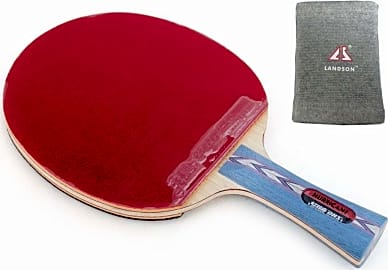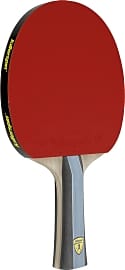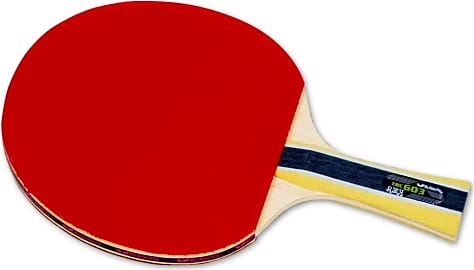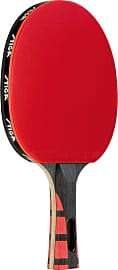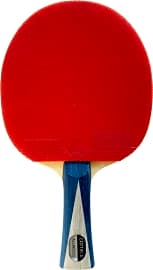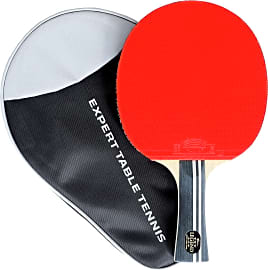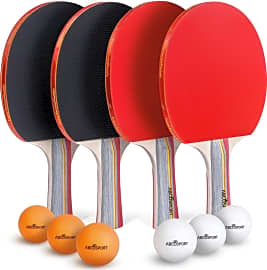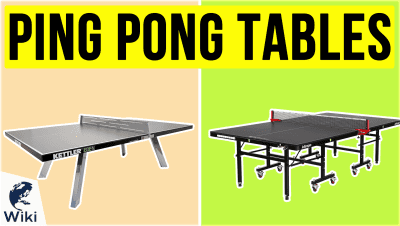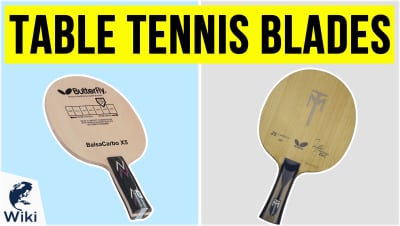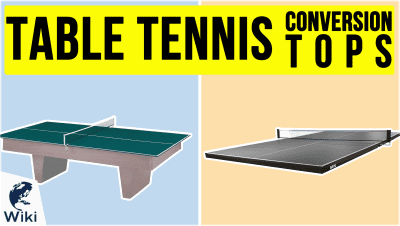The 10 Best Table Tennis Paddles

This wiki has been updated 35 times since it was first published in January of 2017. Though choosing the right table tennis paddle has a lot to do with personal style and preference, there are certain models that will give you a leg up on the competition, no matter your skill or experience level. Taking into account materials, design, playability, and affordability, we've put together a ranking of ten ping pong rackets that are sure to help you step up your game. When users buy our independently chosen editorial recommendations, we may earn commissions to help fund the Wiki.
Editor's Notes
July 11, 2020:
During this latest update we decided to remove the Mapol 4 Star, which is a basic paddle option about the quality of anything you can find at your local big box retailer. Our justification behind this move was simple. We already have the Abco Tech Set, which is of a similar quality and also in the budget price range, and we feel that most people reading this list are really going to be in search of tournament-level rackets.
That being said, we did still wind up replacing a few other options for various reasons. In the case of the Palio Legend 2, the company has released a newer model, the Palio Legend 3.0, which now takes its place. As with the previous iteration, it is really best suited to players who already have a high level of control and need something that can help them increase speed and power.
We also decided to replace the Killerspin JET800 Speed N1 with the Killerspin Kido 7P. The latter features a Fortissimo rubber, as compared to the Nitrx rubber of the JET800, which we feel offers more spin control and a better rebound. Another new addition to the list from Killerspin is the Killerspin Diamond TC RTG, which is a top-of-the-line model. It's price may put it out of reach for the average enthusiast, but those who are playing in competitions will appreciate its premium design. As with the Kido 7P is is equipped with a Fortissimo rubber, but it is enhanced with two layers of titanium in the blade that put a lot of power into shots. We recommend it for users with aggressive playing styles because it is really all about putting together a strong offence to keep opponents on their heels.
Other than the above-mentioned models, all the other paddles on the list retained a place and are still highly recommended by us. The Butterfly 603 and Eastfield Allround are good for users who like to stand close to the table and prefer control and spin over speed and power, while the Stiga Pro Carbon and DHS Hurricane II are well-balanced options perfect for players who switch up tactics throughout a match.
April 17, 2019:
Picking the perfect table tennis paddle is a bit like trying to identify the best food — everybody will have a different opinion. Your personal playing style will determine which model is best for you. With that in mind, we have tried to compile a list that includes bats well-suited to a range of different players, from offensive to defensive. If you like to stand close to the table and prefer precise shot placement and control to overwhelming speed or power, then the Butterfly 603 and Eastfield Allround are for you. On the other hand, more aggressive players who want to conquer their opponents through force will want to take a look at the Killerspin JET800 Speed N1 and Stiga Evolution. The Stiga Pro Carbon, DHS Hurricane II, and Palio Legend 2 are all balanced options that suit well-rounded players who may switch tactics throughout a game. Those just looking for budget-friendly options to put in a rec room for their kids or casual games with friends would be happy enough with the low-cost Abco Tech Set and Mapol 4 Star.
Special Honors
Killerspin Stilo7 SVR With an all-carbon fiber blade, the Killerspin Stilo7 SVR is an exceptionally fast racket and should probably only be in the hands of serious players. It is equipped with Nitrix rubbers and has one of the highest power ratings of any pre-made paddle available. killerspin.com
Cole's Table Tennis If you are ready to step up into the world of custom paddles, Cole's Table Tennis website is a great place to start. Depending on which bat you choose, you can select from various styles for your blade, rubber, and handle, allowing you to get a racket that perfectly fits your exact playing style. colestt.com
Choosing A Table Tennis Paddle
In the same right, recreational players won't need as high quality of a paddle as those who take the sport more seriously.
Each table tennis player will find a different paddle is best suited to their needs. Aggressive players will require a different paddle style than defensive players. In the same right, recreational players won't need as high quality of a paddle as those who take the sport more seriously. Every good paddle is comprised of three main components: the blade, the sponge, and the rubber.
The International Table Tennis Federation rules state that a table tennis paddle's blade must be a minimum of 85 percent natural wood. The other 15 percent can be comprised of a number of different materials, such as carbon or glass fiber. Paddles are generally made from either three, five, or seven layers of wood or other materials. The components of each of these layers will affect the spin, speed, consistency, and ball feel of a paddle, as will the number of layers. For example, a paddle with a harder center ply of wood and a softer exterior ply will offer a compromise between control and speed. A paddle with a hard inner and outer ply will generate more power and speed, but will offer less control. Paddles with more layers are heavier, and can help to add more power to a shot, but this can negatively affect control. This makes them ideal for offensive players, but not as well-suited to defensive playing styles.
Integrating synthetic materials, like the aforementioned carbon fiber, make a blade harder and can also increase the size of the sweet spot. This results in a faster paddle that has a high degree of control and power, which is why many professional players favor this style of paddle. If you like to play close to the table, then a paddle with a carbon fiber component will be a good choice for you, too.
Once you have decided on the type of blade you feel will best fit your playing style, it is time to consider the sponge and rubber, as these can also affect control, speed, and spin. In fact, the rubber and sponge can have such a large impact on how the ball plays that, in 1986, the International Table Tennis Federation mandated that paddles must have a different colored rubber on each side. This is because players at the time were using paddles with the same color rubber on both sides, but different types of rubber. During the game, players would twiddle their paddle, making it difficult for their opponent to know what type of rubber they were hitting the ball with at any given moment, hence not knowing what kind of spin it would impart on the ball.
Thicker sponges are better for attacking and can help you add more spin and speed to a ball, but you sacrifice some control. Thin sponges — those that are less than 2mm thick — are better for defensive players as they offer better ball control, but don't generate as much speed or spin. A good way to counteract this is to purchase a paddle that has a thin sponge, but a very tacky rubber. The tackier the rubber, the more spin you will be able to add to a ball.
Physical And Mental Health Benefits Of Table Tennis
At first glance, table tennis may seem like just a fun way to pass a bit of time, but it actually offers a number of health benefits, as well. Playing table tennis regularly can dramatically improve hand-eye coordination and reflexes. The fast-paced nature of the game requires that a person react quickly and with a high degree of accuracy. This helps to increase fine and gross motor control and gets the body used to performing actions without a lot of time to process incoming information.
Table tennis also burns calories in a fun, exciting, and somewhat addictive way.
Tracking the ball and anticipating its trajectory requires a high degree of mental alertness. Adjusting your paddle placement based on the degree of spin requires problem solving skills. All of this can help develop and improve mental acuity. Alzheimer's Weekly reported a noticeable increase in cognitive awareness in patients who started playing table tennis regularly. A study performed in Japan in 1997 found that table tennis increases blood flow to the brain, making it effective rehabilitation for those suffering from a variety of brain diseases.
Table tennis also burns calories in a fun, exciting, and somewhat addictive way. The average adult burns almost 300 calories in one hour of table tennis. The short bursts of exertion and recovery throughout the game can lead to fast-twitch muscle development, too. Fast-twitch muscles burn more fat than slow-twitch muscles, so the more developed they are, the better your body will be able to burn fat.
A Brief History Of Table Tennis
There are two theories regarding how table tennis came into existence. Some believe that British military officers serving in India in the 1860s and 1870s developed a version of the game in their spare time, which they then brought back to England after their tour of duty finished. Others believe the game was first developed in the 1880s, when tennis players in England adapted their favorite game into a version they could play while stuck indoors during the winter months.
The same year, a British salesman by the name of Edward Shires introduced the game to citizens of Budapest and Vienna.
Wherever its humble beginnings lie, there is no doubt that its popularity grew rapidly. By 1901, people were forming table tennis associations and holding tournaments. They even published a number of books on the subject. In 1902, a Japanese university professor who visited England was so enamored with the game that he brought it back to his home country and introduced it to his students. The same year, a British salesman by the name of Edward Shires introduced the game to citizens of Budapest and Vienna.
The first table tennis world championship, albeit an unofficial one, was held in 1902. In 1926, proponents of the game created the International Table Tennis Federation, decided on a set of international regulations, and held the first official World Championship in London. What had once started as a fun parlor game, was now an official sport that was popular throughout the world.


